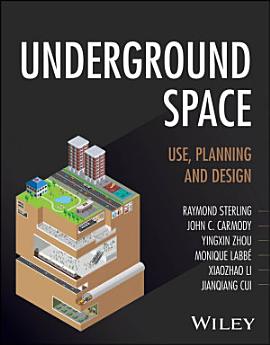Underground Space: Use, Planning and Design
About this ebook
With cities worldwide facing pressures from rapid urbanization, climate change, and land scarcity, underground space has become a vital resource for sustainable and resilient urban development. Underground Space: Use, Planning and Design provides a comprehensive framework for planners, engineers, architects, and policymakers to understand and apply underground solutions and updates a landmark reference work on the topic. Combining many decades of research, practice, and global examples, this book offers authoritative guidance on how underground space can contribute to the creation of livable, future-ready cities.
Written by a team of experts from around the globe, Underground Space offers:
- An understanding of the many reasons why underground space is used and when to choose to build underground.
- Broad coverage of underground uses, from transport and urban utilities to underground architectural applications.
- Recent advances made in three-dimensional urban underground planning.
- Updated design approaches and human-centered considerations for the exterior and interior design, layout, lighting, and safety of underground spaces.
- In-depth exploration of sustainability, resilience, and adaptability issues.
- Insights from several decades of hands-on experience with modern underground designs.
Underground Space: Use, Planning and Design is an essential, up-to-date reference on the subject for architects, planners, and engineers in public agencies, private sectors, and research institutions. It is also valuable for use in courses on architectural design, urban planning, underground infrastructure, and infrastructure provision.
About the author
Raymond Sterling is a Professor Emeritus (Civil Engineering) at Louisiana Tech University where he directed the Trenchless Technology Center from 1995-2009. From 1977-1995, he was on the faculty of the University of Minnesota where he was the founding Director of the Underground Space Center.
John C. Carmody (1947-2019) was an architect and the Associate Director of the Underground Space Center at the University of Minnesota. His major research interests included the planning, design, and construction of underground facilities, energy-efficient building design, building technology, and life safety in buildings.
Yingxin Zhou is Technical Director with Knights Synergy (S) Pte Ltd and Academy of Engineering Singapore and served as Head Engineering (Underground Facilities) with the Defence Science and Technology Agency, Singapore.
Monique Labbé is the recipient of the Pioneering Woman Architect ARVHA Prize in 2023 and runs Les Ateliers Monique LABBÉ. She created and chaired the AFTES Underground Space Committee. She initiated in 2009 and directs the Ville 10D-Ville d’Idées National Research Project on the urban use of the underground.
Xiaozhao Li is Director, Professor of the State Key Laboratory for Geo-Mechanics and Deep Underground Engineering, China University of Mining & Technology. He is also Founding Director of Yunlong Lake Laboratory for Deep Underground Science and Engineering.
Jianqiang Cui is a Senior Lecturer in Urban Planning at Griffith University, Brisbane, Australia. Her research interests lie in the fields of urban planning and design, transport planning and policy, environment and behaviour, and urban underground space.








